Fact: I know a little something about cult films. Having written about the subject for the past 20 years, I can discern what marks out such flicks, and the following ten films, I believe, are all prime candidates for cultdom. The only thing missing? The cults! The problem would appear to be the fact that all these flicks are frustratingly obscure. Let’s hope this article helps to change that.
No, this isn’t the first time I’ve made such a list (and probably not the last), but the previous ones have all been horror themed. Here I’m going to broaden my scope, starting with…
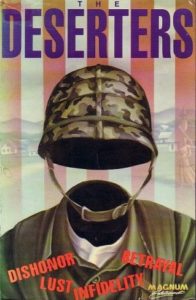 DESERTERS (1983)
DESERTERS (1983)
We can thank the early 1980s VHS boom for this film, whose sole major release was in that format. Staunchly Canadian in look and attitude, it’s a Vietnam drama like no other, galvanized by what may be the best-ever performance by the veteran character actor Alan Scarfe. He plays a deranged American military sergeant who terrorizes a Canadian pacifist (Dermot Hennelly) and his wife (Barbara Marsh, Scarfe’s real-life spouse) about the fact that they allow American military deserters refuge in their home, among them a sniveling-wimp private (Jon Brydon) attempting to elude Scarfe. The film is distractingly low budget, and not a little amateurish, in its approach, but it has a claustrophobic intensity and conceptual audacity that place it in the company of minimalist military-themed classics like THE BRIG and STREAMERS.
EUROCINE 33 CHAMPS ELYSEES (2013)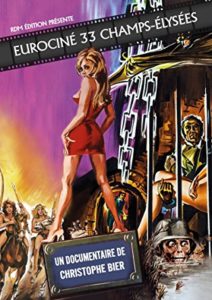
A diverting documentary, running a little over an hour, about the Paris based Eurocine, which churned out quite a few craptaculars in the 1960s, ‘70s and ‘80s. Eurocine’s releases include THE AWFUL DR. ORLOFF, OASIS OF THE ZOMBIES, CANNIBAL TERROR and ZOMBIE LAKE, making them the French equivalent of New World Pictures—although given the middling quality of most of Eurocine’s pics that comparison is probably being far too generous. The majority of this film consists of interviews with Eurocine’s founder Daniel Lesoeur, a former carny whose brand of moviemaking was marked by extreme penny-pinching (with many of his films lensed in his own house). Also interviewed are cast and crewmembers of the Eurocine productions HITLER’S LAST TRAIN (1975) and ELSA FRAULINE (1976). I think it goes without saying that for trash movie buffs EUROCINE 33 CHAMPS ELYSEES is required viewing, whether they know of its existence or not.
 LA FEMME BOURREAU (1968)
LA FEMME BOURREAU (1968)
This loopy black and white psycho-thriller languished in obscurity until 2015, when it was restored and given a deluxe DVD release in its native France. Here in the US, alas, LA FEMME BOURREAU is just as obscure as it was prior to its restoration. That’s a shame, as it’s a fascinating relic of its era, and a tantalizing glimpse into the unique cinematic universe of Jean-Denis Bonan, who could conceivably have gone on to become as distinct a filmmaker as Dario Argento or Jean Rollin (the latter a longtime Bonan associate who played a supporting role in this film). That wasn’t to be, unfortunately, as LA FEMME BORREAU remains Bonan’s only feature. It’s a bit uneven and malformed, showing that the then-26 year old Bonan hadn’t entirely matured as a filmmaker, but the visual flair on display is undeniable. The giallo thrillers of the seventies and Brian De Palma’s DRESSED TO KILL are directly foreshadowed in the narrative, about a lesbian serial killer who’s caught and executed, after which a new set of killings, seemingly committed by another lesbian, commence. Bonan’s many quirky touches include documentary-style man-on-the-street interviews with anonymous Parisians about the killings, and quite a few voyeuristic scenes of women undressing that appear to have been lifted directly from a Russ Meyer flick (although by the film’s end they turn out to have a definite thematic resonance). A neglected classic? Not quite, but LA FEMME BOURREAU is a pleasingly archaic curio that’s well worth your while.
HELL ON EARTH 2: THE ARENA OF DEATH (1992) 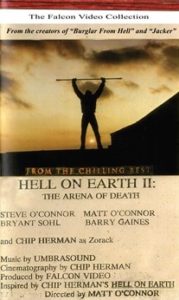
Given the recent surge of interest in late eighties/early nineties shot on video genre fare, HELL ON EARTH 2: THE ARENA OF DEATH (HELL ON EARTH 1, FYI, was an unreleased short) seems overdue for a rediscovery, it being the most ambitious such film that I’ve seen (after the nearly-as-obscure DARK ROMANCES, that is). Shot over the course of six years with a cast of what looks like thousands, it’s about Zorag, a suave serial killer (Phil Herman) stranded in a post-apocalyptic hell-scape populated by radiation-addled mutants. Zorag’s oft-violent interactions with said mutants result in what has to be a record amount of ass-kicking (which resulted in a number of a real-life injuries) amid an assortment of stunningly desolate Queens, NY settings that appear disturbingly convincing as nuclear war-addled scenery. Sure, one has to be forgiving of the crummy sound, uneven pacing and camcorder-worthy visuals (all things that afflict most 1990s SOV fare), but if you can make that leap you’ll find a stark and satisfying chunk of unadulterated mayhem with a haunting atmosphere of otherworldly devastation.
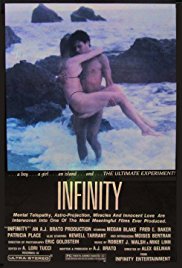 INFINITY (1991)
INFINITY (1991)
One of my most beloved bad movie faves is this jaw-dropper, whose presence was first announced to me when it played at the ‘91 AFI Film Festival—where it was promoted as “One of the Most Important Films Ever Produced.” About a man’s attempt at turning a boy into the next Buddha and/or Jesus on a secluded island, INFINITY is an irresistible combination of new agey earnestness and Ed Woodian cinematic ineptitude. The island, which appears to be the same one inhabited by Gilligan and crew, is visited by a retired mariner and his family, among them a young woman with whom Daniel, the Jesus/Buddha heir, falls in love. This leads to Daniel’s downfall, and apparent death in a tsunami–not to worry, though, because in the final, none-too-haunting line of dialogue we’re informed that “Daniel is fine…Daniel will always be fine!” The apparent purpose of this film was to promote the viewpoints of the late spiritual guru Joel S. Goldsmith (whose “writings, teachings and tapes” are plugged in the end credits), founder of the Infinite Way movement that promotes a weird amalgamation of Christianity and Buddhism. I’m not sure this ridiculous flick was a good way to impart Goldsmith’s beliefs, but it sure makes for some primo bad movie fun.
JOE PRING: HOMICIDE, MANILA POLICE (1989) 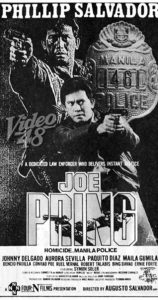
A surprise: this rotgut actioner from the Philippines, which didn’t exactly look promising, turned out to be a strong and impacting piece of work. Starring Filipino superstar Phillip Salvador in the title role of a rogue cop who isn’t afraid to bend the rules to get things done, the film is a mess of cop movie clichés, yet it’s put together with an enormous amount of flair and (of course) a great deal of unflinching violence. In fact, you can count on a bloody shooting, stabbing or beating to occur every few minutes or so as Joe P. tracks a gang of murderous scumbags through the mean streets of Manilla. A kid even gets stabbed at one point—Joe Pring’s own kid, to be exact, which, together with the kidnapping of his wife, sets him off on a kinetic orgy of vengeance, topped off with an intense car joust that prefigures the ending of A BULLET IN THE HEAD. For the record, a JOE PRING 2 appeared in 1991, but from what I’ve seen of that film it doesn’t approach this one.
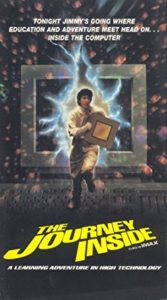 THE JOURNEY INSIDE (1994)
THE JOURNEY INSIDE (1994)
This film, a 40 minute made-for-IMAX mini-feature, is by no means good, or even so-bad-it’s-good. What THE JOURNEY INSIDE is is fascinatingly peculiar, mixing educational drama with grade-Z science fiction while never quite staking its claim in either camp. Financed by Intel, it was intended as a $10 million infomercial for Intel’s Pentium microprocessor, but that gambit was abandoned when Pentium fell out of favor shortly after filming concluded. Thus, all references to it were overdubbed with “Project M” (it, like Pentium, being a three-syllable term that begins with a P and ends with an M), which refers to a microprocessor sought by a band of malevolent space aliens looking to use it to enslave humanity. It’s up to a plucky little boy (Tim Farrell) to save the day by getting shrunk down to insect size and, as the title promises, journeying into the innards of a computer.
THEORIE DE LA RELIGION (2010) 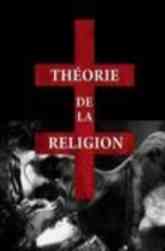
This sickie brought back the queasiness I felt upon viewing NEKROMANTIK, MAN BITES DOG and the GUINEA PIG flicks for the first time. Yes, THEORIE DE LA RELIGION, an hour-long gross-out extravaganza by the famed experimental filmmaker Frederick Maheux, is that ground-breaking and uncompromising. An unremittingly vile piece of work, it consists of an unidentified slob wreaking all manner of unspeakable acts upon a female mannequin. It may not sound especially gruesome or compelling, but as the film advances it grows undeniably impactful, as it’s clear this guy is a profoundly disturbed individual whose grasp of reality is tenuous at best, while the handheld visuals, which initially seem undisciplined, have a definite artistic sheen. Getting back to the abovementioned nineties-era films, it’s important to admit that I (and most likely you) first viewed them in bootleg format, which is explicitly referenced here in video effects (sudden bursts of static, etc.) that are meant to mimic the visual distortions of a multi-generation bootleg VHS. As for THEORIE DE LA RELIGION’S blink-and-you’ll-miss-it distribution, it was accomplished via, appropriately enough, VHS.
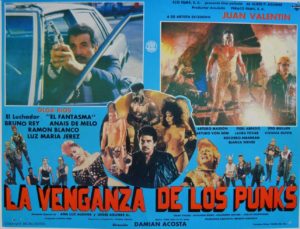 LA VENGANZA DE LOS PUNKS (VENGANZA INSACIABLES; 1987)
LA VENGANZA DE LOS PUNKS (VENGANZA INSACIABLES; 1987)
Another instance of exuberantly trashy third world action moviemaking, and a rare example of a sequel that actually improves on its predecessor. LA VENGANZA DE LOS PUNKS was a direct follow-up to 1980’s INTREPIDOS PUNKS, which has enjoyed a reasonably strong cult following on these shores. Not so with VENGANZA, even though it is, again, the better film—it’s a veritable exploitation movie masterpiece, in point of fact. The focus is on the cop who helped bring down the colorfully attired punks of the first movie; the surviving members of the gang get together and break their leader, a Santo-outfitted freak, out of prison, and immediately go after said cop’s family. This entails a gratuitous rape scene—a gang rape, actually—which inspires the protagonist to track the punks back to their lair and methodically kill them off, cackling maniacally all the while. His methodology includes entrapment in a well with a poisonous snake, acid poured on a prone woman’s body, eyeball gouging, impalement via a sharp stake through the head, burning, decapitation, etc. I think you’ve got the drift: this is crazy shit that ain’t for wimps, being every bit as wild, outrageous and, ultimately, satisfying as you might expect.
THE VOYAGE OF TANAI (1975)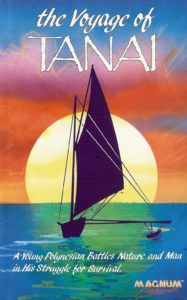
Yet another forgotten relic from the VHS era. Released by Magnum Entertainment in an oversized clamshell case, THE VOYAGE OF TAINAI is an altogether odd Italian made dramatization of an ancient legend (or so the filmmakers claim) about a young boy who makes an epic sea voyage from Polynesia to Alaska on a tiny raft, guided by the voice of his ancestors. I mean that literally: a gravelly male voice sounding like that of Optimus Prime from the TRANSFORMERS flicks is actually heard on the soundtrack, instructing Tanai on how to survive (and nearly always beginning his sentences with the words “Now remember, Tanai…”). Beyond that the film is a pleasingly scenic account with many strikingly exotic settings—Easter Island, etc.—and mondo-esque footage that nearly makes up for the complete lack of human drama.
